A couple of weeks ago as part of the Birding Seminar at Sheldon Jackson College, we had the opportunity to hear from Michelle Kissling, a Biologist with the USFWS, and Stephen Lewis, Biologist with ADF&G. They have been leading a 3 year study of breeding forest owls in Southeast Alaska that is entering its third year. One of their goals is to establish a long-term monitoring program of owls in Southeast Alaska which they hope will continue on long after this intial study is completed.
Sitka is apparently unusual in Southeast for the number of Western Screech Owls. Sitka also seems to be lacking in Northern Saw-whet and Barred owls which are two of the more common owls elsewhere in the region. It is unclear why this might be the case.
Although the talk was interesting, the activities that took place after the talk were even more engaging. While they were in town, they had agreed to help SHS biology teacher Kent Bovee and one of his students capture a screech owl and outfit it with a radio transmitter. They had just missed capturing one earlier in the evening (before the talk) out at Starrigavan, and we suggested they try around campus. I hear screech owls around my house fairly often, and I found out from students that they see them fairly often at night as well. What follows is my account (with photos; click on images to see larger versions) of the process I observed that evening.
It was getting close to 10pm when we finally left Rasmuson and headed out to try calling in an owl. Steve grabbed the blaster out of their vehicle and we first tried calling on the road by the flume end of Yaw Building. After a couple of minutes there with no observed activity, we moved over on the access road behind the gym. Shortly after the calls started playing, we saw an owl fly over and land in the branches. It stayed back a bit and did not return the calls, but it did seem curious.
Somewhat surprised by the presence of an owl, a couple of members of the group departed hastily to get the vehicle and bring it back. When they returned others went to help with the mist net and other assorted gear for capturing the bird while Kitty and I stood watch with the caller. While we were waiting, we saw another owl fly off from in front of the gym over toward the forest along the flume. The owl we were focused on was remarkably patient, as we all waited for the others to return.
When the mist net and other gear arrived, it was quite a scene to watch everyone trying to work quickly to get things set up. Before they got started, they asked me if anyone would be driving down the road. I naively said, “Of course not, it’s pretty late and this road isn’t used much anyway.” So they went to work setting the mist net up across the road. If you haven’t ever seen a mist net before, they are remarkably tangle-prone and difficult to see. It took a little doing to get the net untangled and ready to string up. Before they got it all set up, the owl took off and flew into the trees. We went ahead and continued with the operation, in the hopes that the owl was still watching nearby and might be lured back.
While we were waiting and hoping for the owl to come back we spotted some headlights shining down the road from around the bend. Kitty and I walked up the road to let the folks know they would need to turn around. A minutes later, a second vehicle came down the road. This one was driven by one of Kitty’s Natural History students who took an interest in the whole operation and stayed to watch.
All this time I was getting kind of cold and wishing I had my camera, but as seems to occur more often than I prefer, I assumed I was going to a talk in a warm building with no need to take photos and was woefully unprepared.
After 15 minutes or so, the campus security man drove up to check out what we were doing. He commented that he often saw owls behind Rasmuson along the flume. Both students who were now watching said they also had been seeing them there a couple of times a week around 10pm.
With no additional owl activity, everyone helped move the entire operation over behind Rasmuson near where the flume water goes through the culverts under the road. At this point, Kent and Kam decided to go get Kam’s “Owl Baiter 2000”, a home-built bait station that tempts owl with the offer of a live mouse. I decided it was in my best interests to run home and grab some warmer clothing and my camera, so I took a few minutes to do that.
I came back down the hill about the time Kam and Kent returned. The owl flew across, just to the side of the net, as we were walking down the road. That got us a little excited, but we did not see any more owl action for some time. Meanwhile, the snow started to fall and we were all standing around waiting. Kitty was getting a little concerned about the late hour and her boat commute to get home, so I suggested that she go ahead and go so we could catch an owl right after she left. After a few more minutes, she decided to “take one for the team” and left for home. Not five minutes after she left, an owl flew right between those of us standing in the street watching (thanks Kitty).
We did not realize it at first, but the owl that flew between us had landed in a branch over the flume not far from the net. We finally realized it was there and someone alerted Kam to its presence (he was standing up closer to the net, while the rest of us were some distance back). Finally, the “Owl Baiter 2000” became unresistable and the owl flew in to snatch the mouse. Just after grabbing the mouse, it ran into the mist net and was caught.
(click on photos to see larger image)
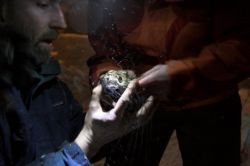
Steve and Michelle quickly ran up to the owl to get it in hand and start working on getting it removed from the net. This was a delicate process which required care to avoid injuring the bird (and getting injured by the bird); a process complicated by the difficulty of seeing the net in the cold and snowy semi-darkness.
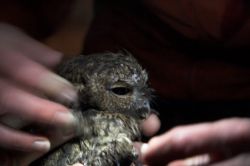
After a few minutes of work, the owl was finally free of the net. It was put in a cloth bag to help it stay calm during transportation. Kent asked me if I had a key to a building where they could do the work measuring the bird and outfitting it with a transmitter. Michelle said they normally did what they needed in their truck, but it would be nice to have a little more room (and warmth). The laundry building seemed like the best option, as it was open, lit, and had large tables; so that is where we went.
Once we were all inside and all the necessary tools were laid out on the table, the initial measurements and leg banding went quickly. The longest part of the process was getting the radio transmitter put on. The transmitter is worn like a backpack with teflon straps (the birds can bite through cotton straps). It is arranged so the transmitter is in the middle of the back, and a small aluminum clasp holds the straps together. The owls typically pull at the straps went they first get them, but seem to get used to them. It does not take long for the birds to preen the straps under the feathers so they are no longer even noticable. None of this seems to be particularly difficult, but it does take time to get things adjusted properly.

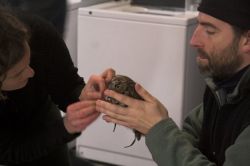
Michelle works on getting the straps around the wings while Steve holds the owl.
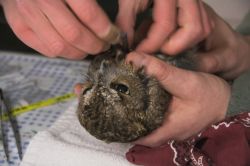
Michelle adjusts the tightness of the straps.
One interesting thing is the bird was much more calm when placed on its back. Steve commented that in nature, an owl would almost never find itself on its back unless it had been caught by a predator.
Steve and Michelle checked carefully to make sure the transmitter was positioned correctly on the owl’s back. They also checked to make sure the clasp on the front was positioned correctly. The important thing on the front was to keep it low enough so it did not press in on the bird’s crop and keep it from being able to expel cough pellets.
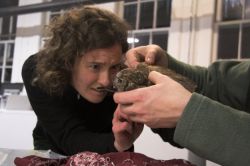
Michelle checks the strap under the wing.
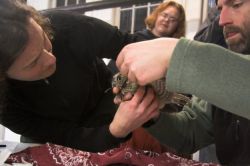
Michelle adjusts the straps for better fit.

Michelle crimps the aluminum clasp for the straps.
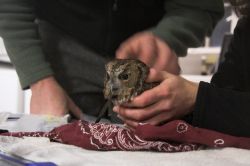
Finished attaching the transmitter.
After the aluminum clasp was crimped to keep the straps positioned correctly, the excess on the straps needed to be cut off. Super glue was used to keep the ends from fraying. In order to avoid getting glue in the feathers, Michelle used a small piece of filefolder material as a barrier between the glue and feathers.
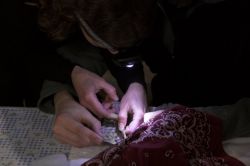
The most difficult and stressful part of the process was drawing blood.
Owl veins are apparently very small, and it took several tries to get the necessary blood sample. Michelle said that this was part she found most stressful, and I am sure the bird wasn’t too thrilled with it either.
Steve, Kameron, and Michelle talk a little bit about handling the owl and what needs to be done to track it over the coming months.
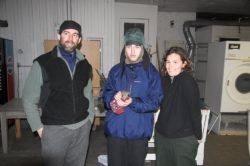
Kameron’s high school senior project is to study the screech owls. He would like to become a wildlife biologist.
Ryan and Nate are two Sheldon Jackson College students who watched the process from the time they drove up in their truck on the road behind the gym. They were each able to hold the owl briefly before it was released.
Kameron released the owl back into the night. At first it did not realize it was free to go, but after a few moments it flew to a branch in one of the nearby alders. Soon after it landed, it started tugging on the straps that were holding the transmitter on. Steve said they normally do this for a little while before accepting and then ignoring them.
![]()
Kameron and Kent try to get a location for the Owl
The next day, Kameron and Kent came over to campus to try tracking the owl. We were able to narrow it down to the end of Hillcrest Drive, but were unable to get a visual of it. These owls are very cryptic and easy to overlook. One of the most impressive slides that was in the slide show looked like a normal tree trunk. Only after it was pointed out did people realize the trunk actually had a cavity with a Western Screech Owl standing in it. It was not just a small part of owl either, but even when the audience was told there was an owl in the picture, it had to be carefully outlined before people could see it.
After finding the bird Friday, neither Kameron nor Kent were able to get a location on it in subsequent days. In fact, the signal seemed to have disappeared completely. Michelle said the bird was probably a first year male still on the territory where it was raised when it was captured. It is not unexpected for such owls to disperse at some point; possibly traveling several miles away. The range of the transmitter is only 2 miles, so it remains to be seen whether we can discover where the owl has gone.
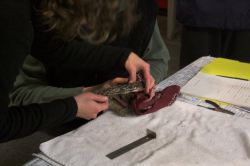
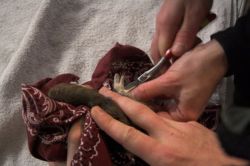
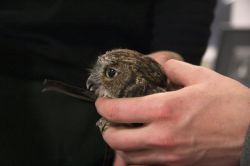
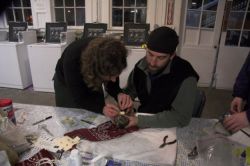
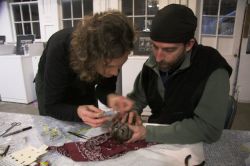

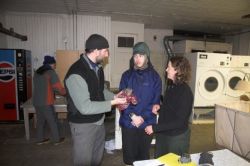
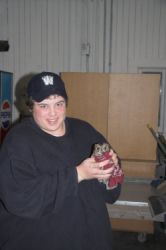
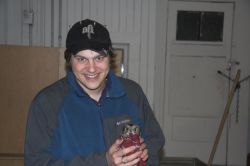
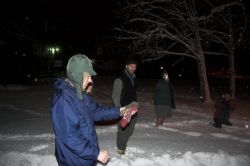

Great- it will make the people who were not there a little more motivated to get to
the meetings, snow or not!! Thank you for sharing! JZA
Dear Colleague
I’ve briefly checked your home page with link of use of Radio transmitter.
I’m Lagagas yBiologist from ASITY (Malagasy BirdConservation)NGO.
We are planning to monitor species like Common Barn Owl and Madagascar Red Owl in and suround rain forest project site.
Can you suggest the name of compagny in which we can contact to order sample of radio transmitters,transmitter receiver
and antenna. At least we need model weighting (4-7g and battery duration up to 6-12 months or more.
If you have any information or home page of Radio transmitters manufacurer, please forward them to me.
All my best
Marc